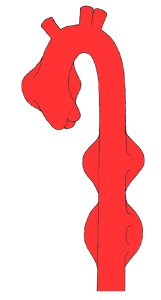Think about it.
Right from your birth, till you die, there
is this pipe , (thats one way of looking at it), constantly handling
the transport of blood.
Non-stop.
Depending on how sensibly you have lived, or
are living, the walls of your aorta may or may not have plaque on them.
Then, in addition, this main artery does not meander thru a clean barren
landscape....it basically finds its way through a slew
of organs like the lungs, liver , stomach,
etc, all clobbering up the space. And if you are one of those indulgent
types, there is all that adipose tissue(fatty tissue to all you newbies)
trying to press around here and there.
The point to be made, is , that like all human
endeavours, this aorta, after years and years of faithfully negotiating
the terrain, gets subjected to wear and tear,
and even fatugue.
Thats when we start seeing slackness
in the aortic walls. A swelling here, a lump
there. When the size of this gets significantly
bigger, it starts affecting blood flow in the body. The heart, which is
trying to pump this blood around, starts feeling the difference in its
pumping ability. And you start showing problems with blood pressure !
|
 |
These swellings in the aorta, are called aneurysms.
Mostly detected when someone asks you to do an abdominal
ultrasound exam. Swellings upto 5 cms in diameter
one does not get desperate about. Anything more than 5 cms, and you start
to lose sleep (that is, your family, not you).
There are various places along the aorta
that the swellings can turn up. Sometimes they are in the chest
part of the aorta, somewhere behind the heart.
Thats a very dangerous place for these things to be. Sometimes , they are
lower down, as the aorta descends the abdominal
cavity. If the aneurysm or swelling occurs
before the aorta forks into renal arteries (taking blood to the kidneys),
then this is said to be "supra-renal".
Any trouble with this aneurysm, immediately affects the blood flow to the
kidneys, causing BP problems, giddiness etc etc. Someyimes the swelling
in the aorta is below the renal arteries. This is comparatively the least
harmless place it can be.
Males
are , for some reason, more prone to these aneurysms. The
following pages were a result of my search for information and understanding,
when a close family member was diagnosed with a n abdominlal
aortic aneurysm.
|